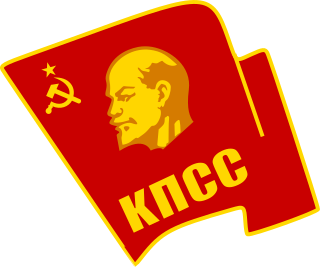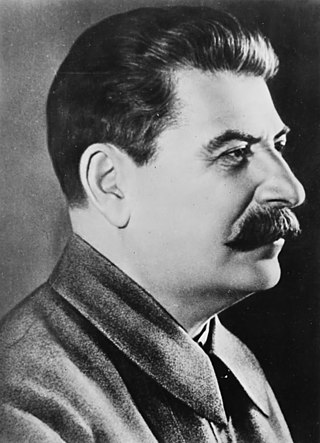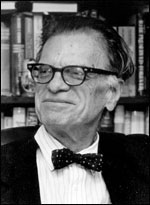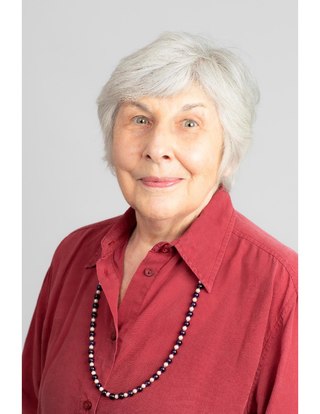Related Research Articles

The Communist Party of the Soviet Union (CPSU), at some points known as the Russian Communist Party, All-Union Communist Party and Bolshevik Party, and sometimes referred to as the Soviet Communist Party (SCP), was the founding and ruling political party of the Soviet Union. The CPSU was the sole governing party of the Soviet Union until 1990 when the Congress of People's Deputies modified Article 6 of the 1977 Soviet Constitution, which had previously granted the CPSU a monopoly over the political system. The party's main ideology was Marxism–Leninism.
Marxism–Leninism is a communist ideology that became the largest faction of the communist movement in the world in the years following the October Revolution. It was the predominant ideology of most communist governments throughout the 20th century. It was developed in Russia by Joseph Stalin and drew on elements of Bolshevism, orthodox Marxism, and Leninism. It was the state ideology of the Soviet Union, Soviet satellite states in the Eastern Bloc, and various countries in the Non-Aligned Movement and Third World during the Cold War, as well as the Communist International after Bolshevization.

Stalinism is the totalitarian means of governing and Marxist–Leninist policies implemented in the Soviet Union (USSR) from 1927 to 1953 by dictator Joseph Stalin. Stalin had previously made a career as a gangster and robber, working to fund revolutionary activities, before eventually becoming General Secretary of the Soviet Union. Stalinism included the creation of a one man totalitarian police state, rapid industrialization, the theory of socialism in one country, forced collectivization of agriculture, intensification of class conflict, a cult of personality, and subordination of the interests of foreign communist parties to those of the Communist Party of the Soviet Union, which Stalinism deemed the leading vanguard party of communist revolution at the time. After Stalin's death and the Khrushchev Thaw, a period of de-Stalinization began in the 1950s and 1960s, which caused the influence of Stalin's ideology to begin to wane in the USSR.

Totalitarianism is a political system and a form of government that prohibits opposition political parties, disregards and outlaws the political claims of individual and group opposition to the state, and controls the public sphere and the private sphere of society. In the field of political science, totalitarianism is the extreme form of authoritarianism, wherein all socio-political power is held by a dictator, who also controls the national politics and the peoples of the nation with continual propaganda campaigns that are broadcast by state-controlled and by friendly private mass communications media.

The ten years 1917–1927 saw a radical transformation of the Russian Empire into a socialist state, the Soviet Union. Soviet Russia covers 1917–1922 and Soviet Union covers the years 1922 to 1991. After the Russian Civil War (1917–1923), the Bolsheviks took control. They were dedicated to a version of Marxism developed by Vladimir Lenin. It promised the workers would rise, destroy capitalism, and create a socialist society under the leadership of the Communist Party of the Soviet Union. The awkward problem, regarding Marxist revolutionary theory, was the small proletariat, in an overwhelmingly peasant society with limited industry and a very small middle class. Following the February Revolution in 1917 that deposed Nicholas II of Russia, a short-lived provisional government gave way to Bolsheviks in the October Revolution. The Bolshevik Party was renamed the Russian Communist Party (RCP).

The Communist International (Comintern), also known as the Third International, was an international organization founded in 1919 that advocated world communism, and which was led and controlled by the Communist Party of the Soviet Union. The Comintern resolved at its Second Congress in 1920 to "struggle by all available means, including armed force, for the overthrow of the international bourgeoisie and the creation of an international soviet republic as a transition stage to the complete abolition of the state". The Comintern was preceded by the dissolution of the Second International in 1916.
Soviet and communist studies, or simply Soviet studies, is the field of regional and historical studies on the Soviet Union and other communist states, as well as the history of communism and of the communist parties that existed or still exist in some form in many countries, both inside and outside the former Eastern Bloc, such as the Communist Party USA. Aspects of its historiography have attracted debates between historians on several topics, including totalitarianism and Cold War espionage.
Robert Charles Tucker was an American political scientist and historian. Tucker is best remembered as a biographer of Joseph Stalin and as an analyst of the Soviet political system, which he saw as dynamic rather than unchanging.
John Archibald Getty III is an American historian and professor at the University of California, Los Angeles (UCLA), who specializes in the history of Russia and the history of the Soviet Union.
Communism is a left-wing to far-left sociopolitical, philosophical, and economic ideology within the socialist movement, whose goal is the creation of a communist society, a socioeconomic order centered around common ownership of the means of production, distribution, and exchange that allocates products to everyone in the society based on need. A communist society would entail the absence of private property and social classes, and ultimately money and the state.

Adam Bruno Ulam was a Polish-American historian of Jewish descent and political scientist at Harvard University. Ulam was one of the world's foremost authorities and top experts in Sovietology and Kremlinology, he authored multiple books and articles in these academic disciplines.
Soviet historiography is the methodology of history studies by historians in the Soviet Union (USSR). In the USSR, the study of history was marked by restrictions imposed by the Communist Party of the Soviet Union (CPSU). Soviet historiography is itself the subject of modern studies.

Sheila Mary Fitzpatrick is an Australian historian, whose main subjects are history of the Soviet Union and history of modern Russia, especially the Stalin era and the Great Purges, of which she proposes a "history from below", and is part of the "revisionist school" of Communist historiography. She has also critically reviewed the concept of totalitarianism and highlighted the differences between Nazi Germany and the Soviet Union in debates about comparison of Nazism and Stalinism.

Before the perestroika Soviet era reforms of Gorbachev that promoted Eurocommunism, the formal ideology of the Communist Party of the Soviet Union (CPSU) was Marxism–Leninism, a form of socialism consisting of a centralised command economy with a vanguardist one-party state that aimed to realize the dictatorship of the proletariat. The Soviet Union's ideological commitment to achieving communism included the national communist development of socialism in one country and peaceful coexistence with capitalist countries while engaging in anti-imperialism to defend the international proletariat, combat the predominant prevailing global system of capitalism and promote the goals of Russian Communism. The state ideology of the Soviet Union—and thus Marxism–Leninism—derived and developed from the theories, policies and political praxis of Marx, Engels, Lenin and Stalin.

Joseph Stalin started his career as a radical student, becoming a robber, gangster as well as an influential member and eventually the leader of the Bolshevik faction of the Russian Social Democratic Labour Party. He served as the General Secretary of the Central Committee of the Communist Party of the Soviet Union from 1922 until his death in 1953.

Lev Borisovich Kamenev was a Russian revolutionary and Soviet politician. He was born in Moscow to parents who had both been involved in revolutionary politics in the 1870s. He joined the Russian Social Democratic Labour Party (RSDLP) in 1901 and was active in Moscow and Saint Petersburg. Kamenev participated in the failed Russian Revolution of 1905. Relocating abroad in 1908, he became an early member of the Bolsheviks and a close associate of the exiled Vladimir Lenin. In 1914, he was arrested upon returning to Saint Petersburg and exiled to Siberia. Kamenev was able to return after the February Revolution of 1917, which overthrew the Tsarist monarchy. In 1917, he served briefly as the equivalent of the first head of state of the All-Russian Congress of Soviets. He disagreed with Lenin's strategy of armed uprising during the October Revolution but nevertheless remained in a position of power after the fall of the Provisional Government. In 1919, Kamenev was elected a full member of the first Politburo.

The Central Committee of the Communist Party of the Soviet Union was the highest organ of the Communist Party of the Soviet Union between two congresses. According to party statutes, the committee directed all party and governmental activities. The Party Congress elected its members.
Soviet democracy, or council democracy, is a type of democracy in Marxism, in which the rule of the population is exercised by directly elected soviets, or workers' councils. The councils are directly responsible to their electors and bound by their instructions using a delegate model of representation. Such an imperative mandate is in contrast to a trustee model, in which the elected delegates are only responsible to their conscience. Delegates may accordingly be dismissed from their post at any time or be voted out (recall).

Foundations of Leninism was a 1924 collection made by Joseph Stalin that consisted of nine lectures he delivered at Sverdlov University that year. It was published by the Soviet newspaper, Pravda.
The Bloc of Oppositions, also known as Trotsky's bloc and called by the Soviet press the Bloc of Rights and Trotskyites, was a political alliance created by oppositionists in the USSR and Leon Trotsky by the end of 1932. Trotsky defined it as a conspiratorial bloc in order to fight Stalinist repression in the Soviet Union.
References
- ↑ ""Kremlinology" definition". merriam-webster.com. Merriam-Webster Online. Retrieved 16 February 2015.
Definition of KREMLINOLOGY: the study of the policies and practices of the former Soviet government
- ↑ Armstrong, Charles K. (February 1999). "[Review of the book] North Korea after Kim Il Sung. Edited by Dae-Sook Suh and Chae-Jin Lee". The Journal of Asian Studies. 58 (1): 224–225. doi:10.2307/2658450. JSTOR 2658450 . Retrieved 6 September 2023.
- ↑ Yury Solodukhin (2009). "The Logical Doctrine of Alexander Zinoviev" (Alexander Alexandrovich Zinoviev). Moscow: ROSSPEN. pp. 133–152.
- ↑ Karl Kantor (2009). "The Logical Sociology of Alexander Zinoviev as a Social Philosophy" (in Russian).
- ↑ Sarah Davies; James Harris (8 September 2005). "Joseph Stalin: Power and Ideas". Stalin: A New History. Cambridge University Press. p. 3. ISBN 978-1-139-44663-1.
Academic Sovietology, a child of the early Cold War, was dominated by the 'totalitarian model' of Soviet politics. Until the 1960s it was almost impossible to advance any other interpretation, in the USA at least.
- ↑ Sarah Davies; James Harris (8 September 2005). "Joseph Stalin: Power and Ideas". Stalin: A New History. Cambridge University Press. pp. 3–4. ISBN 978-1-139-44663-1.
In 1953, Carl Friedrich characterised totalitarian systems in terms of five points: an official ideology, control of weapons and of media, use of terror, and a single mass party, 'usually under a single leader'. There was of course an assumption that the leader was critical to the workings of totalitarianism: at the apex of a monolithic, centralised, and hierarchical system, it was he who issued the orders which were fulfilled unquestioningly by his subordinates.
- 1 2 Sarah Davies; James Harris (8 September 2005). "Joseph Stalin: Power and Ideas". Stalin: A New History. Cambridge University Press. pp. 4–5. ISBN 978-1-139-44663-1.
Tucker's work stressed the absolute nature of Stalin's power, an assumption which was increasingly challenged by later revisionist historians. In his Origins of the Great Purges, Arch Getty argued that the Soviet political system was chaotic, that institutions often escaped the control of the centre, and that Stalin's leadership consisted to a considerable extent in responding, on an ad hoc basis, to political crises as they arose. Getty's work was influenced by political science of the 1960s onwards, which, in a critique of the totalitarian model, began to consider the possibility that relatively autonomous bureaucratic institutions might have had some influence on policy-making at the highest level.
- ↑ Lenoe, Matt (2002). "Did Stalin Kill Kirov and Does It Matter?". The Journal of Modern History. 74 (2): 352–380. doi:10.1086/343411. ISSN 0022-2801. S2CID 142829949.
- ↑ Sheila, Fitzpatrick (2007). "Revisionism in Soviet History". History and Theory. 46 (4): 77–91. doi:10.1111/j.1468-2303.2007.00429.x. ISSN 1468-2303.
[...] the Western scholars who in the 1990s and 2000s were most active in scouring the new archives for data on Soviet repression were revisionists (always 'archive rats') such as Arch Getty and Lynne Viola.
- ↑ Lawson, Eugene K. (1984). The Sino-Vietnamese Conflict. Praeger. pp. 8–9.
- ↑ Poland is in the Eurasian Union: the mythology of Russian-Polish relations. Eurasian Club East - West, October 2012 Archived 2012-12-07 at the Wayback Machine
- ↑ Salmon, Andrew (2 January 2012). "'Kremlinology' used to watch North Korea". The Washington Times. Retrieved 10 January 2019.
- ↑ Nakagawa, Ulara (29 September 2010). "The Art of 'Pyongyangology?'". The Diplomat. Retrieved 25 January 2019.